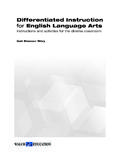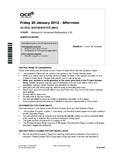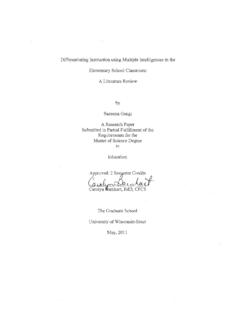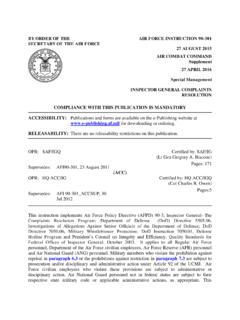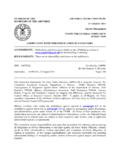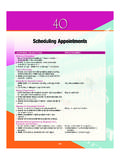Transcription of Differentiated Instruction for Social Studies - Walch
1 Differentiated InstructionforSocial StudiesInstructions and activities for the diverse classroomWendy Wilson and Jack PapadonisTTaabbllee ooff CCoonntteennttssIntroduction to Differentiated Instruction ..ivThe Ten Themes of the Social Studies Standards ..viiLesson 1: A Columbian Banquet: The Great Exchange .. 1 Lesson 2: Creating a Children s Book on Case Law .. 5 Lesson 3: A Medieval Fair .. 9 Lesson 4: A Museum Display on the American West .. 13 Lesson 5: Join the WPA and Design a Mural .. 19 Lesson 6: A Who Am I? Tea Party .. 23 Lesson 7: History Hall of Fame .. 27 Lesson 8: Stop the Presses! .. 35 Lesson 9: Tax Cut or Public Works Investment? .. 38 Lesson 10: The Powers of Congress .. 41 Lesson 11: Worse Than Slavery .. 45 Lesson 12: Make Your Own Revolution .. 49 Lesson 13: Where Would You Place a Settlement? .. 54 Lesson 14: Demographic Statistics on African Nations.
2 57 Lesson 15: Points of Longitude and Latitude .. 63 Lesson 16: Creating Climographs .. 65 Lesson 17: A Lesson in Archaeology: Build Your Baulk .. 69 Lesson 18: The Ellis Island Experience: A Simulation .. 72 Lesson 19: The Growth of the United States, 1865 1920 .. 82 Lesson 20: What Happened Here? A Study of Genocide .. 86 Differentiated Instruction for Social Studies 2006 Walch Publishingiiiiv 2006 Walch PublishingDifferentiated Instruction for Social StudiesIInnttrroodduuccttiioonn ttoo DDiiffffeerreennttiiaatteedd IInnssttrruuccttiioonnDifferentiated Instruction for Social Studiesprovides twenty Social Studies lessons that covermany of the disciplines of a typical Social Studies curriculum such as American history, worldhistory, geography, and civics. Many lessons can be adapted for use with several topics, andall of the lessons encompass several Social Studies strands and several of the multipleintelligences.
3 The lessons are designed to provide you with models of differentiatedinstruction to meet the diverse learning needs of your Ann Tomlinson in The Differentiated Classroom: Responding to the Needs of All Learnersencourages educators to look at teaching and learning in a new way. Using the phrase Onesize doesn t fit all, she presents a philosophy of educational beliefs: Students must be seen as individuals. While students are assigned grade levels by age,they differ in their readiness to learn, their interests, and their style of learning. These differences are significant enough to require teachers to make accommodations anddifferentiate by content, process, and student products. Curriculum tells us what to teach;differentiation gives us strategies to make teaching more successful. Students learn best when connections are made between the curriculum, student interests,and students previous learning experiences.
4 Students should be given the opportunity to work in flexible groups. Different lessonspoint toward grouping students in different ways: individually, heterogeneously,homogeneously, in a whole group, by student interests, and so forth. There should be ongoing assessment to help plan effective address the diverse ways that students learn and their learning styles, we can look toHoward Gardner s eight intelligences to provide a framework. Gardner s theory of multipleintelligences encourages us to scrutinize our attitudes toward learning so that each studentcan learn in a more relaxed s explore what multiple intelligences look like in the Social Studies /SpatialPerceives the visual world with accuracy; can transform and visualize threedimensions in a two-dimensional space. Encourage this intelligence by usinggraphs and making sketches, exploring spatial visualization problems, and usingmapping Instruction for Social Studies 2006 Walch PublishingvVerbal/LinguisticAppreciates and understands the structure, meaning, and function of students can communicate effectively in both written and verbal this intelligence by using class to discuss ideas, making written andoral presentations, and doing research to recognize logical or numerical patterns and observe patterns insymbolic form.
5 Enjoys problems requiring the use of deductive or inductivereasoning and is able to follow a chain of reasoning. Encourage this intelligenceby organizing and analyzing data, designing and working with spreadsheets,working on critical-thinking and estimation problems, and helping studentsmake predictions based on the analysis of numerical ability to produce and/or appreciate rhythm and music. Students may enjoylistening to music, playing an instrument, writing music or lyrics, or moving tothe rhythms associated with music. Activities related to this intelligence includeusing songs to illustrate skills and/or ability to handle one s body with skill and control, such as dancers, sportsstars, and craftspeople. Students who excel in this intelligence are often hands-onlearners. Activities related to this intelligence include the use of manipulatives,involvement with hands-on activities, and permitting students to participate inactivities that require movement or relate physical movements to ability to pick up on the feelings of others.
6 Students who excel in thisintelligence like to communicate, empathize, and socialize. Activities related tothis intelligence include using cooperative-learning groups, brainstorming ideas,employing a creative use of grouping (including heterogeneous, homogeneous,self-directed, and so forth), and using long-range group and being in touch with one s feelings is at the center of thisintelligence. Activities related to this intelligence include encouraging studentsto be self-reflective and explain their reasoning, using journal questions tosupport metacognition, and giving students quiet time to work 2006 Walch PublishingDifferentiated Instruction for Social StudiesNaturalistNaturalist intelligence deals with sensing patterns in and making connections to elements in nature. These students often like to collect, classify, or read about things from nature rocks, fossils, butterflies, feathers, shells, and the like.
7 Activities related to this intelligence include classifying objects basedupon their commonalities, searching for patterns, and using Venn diagrams tohelp organize Format of the BookThe twenty reproducible lessons in this book have been developed to takeadvantage of a number of differentiation strategies. These include: Student-centered activities, where the teacher acts as a guide to foster students self-reliance as learners A variety of instructional materials Varying approaches to assessment, including nontraditional assessment andassessment by multiple means Flexibility in how the teacher presents the material Flexible grouping options, with suggestions regarding activities that work bestas individual projects, for pairs, and for small groups. Flexible time to complete projects according to student levels and needs Multiple-option assignments, where students are given a choice of ways topursue a topic and present concepts Multiple perspectives on ideas and events are encouraged.
8 Students are encouraged to problem-solve independently, to use theirbackground knowledge, and to use their individual talents and skills Students are encouraged to make interest-based learning choices. Multiple intelligences are addressed in each activity, and are listed on theteacher can either use these lessons as they are presented, or adapt them to your owncurriculum. The curriculum standards produced by the National Council for theSocial Studies have been a guide in setting up lessons that conform to the socialstudies standards. It is hoped that these lessons will further serve as a springboardfor you to use your own ingenuity to rework lessons to meet the unique abilitiesof all TTeenn TThheemmeess ooff tthhee SSoocciiaall SSttuuddiieess SSttaannddaarrddssIn 1994, the National Council for the Social Studies approved a set of standards for theteaching of Social Studies nationwide.
9 An integral part of this was the setting out of tenthemes, or strands, that can serve as the organizing principle for classroom curriculum. Not only are these strands interrelated, but they are drawn from all of the Social studiesdisciplines and Social sciences so that they are broad and all-encompassing. The ten strands areI. CULTURES ocial Studies programs should include experiences that provide for the study of culture andcultural TIME, CONTINUITY, AND CHANGES ocial Studies programs should include experiences that provide for the study of the wayshuman beings view themselves in and over PEOPLE, PLACES, AND ENVIRONMENTSS ocial Studies programs should include experiences that provide for the study of people,places, and INDIVIDUAL DEVELOPMENT AND IDENTITYS ocial Studies programs should include experiences that provide for the study of individualdevelopment and INDIVIDUALS, GROUPS, AND INSTITUTIONSS ocial Studies programs should include experiences that provide for the study of interactionsamong individuals, groups, and Instruction for Social Studies 2006 Walch PublishingviiVI.
10 POWER, AUTHORITY, AND GOVERNANCES ocial Studies programs should include experiences that provide for the study of how peoplecreate and change structures of power, authority, and PRODUCTION, DISTRIBUTION, AND CONSUMPTIONS ocial Studies programs should include experiences that provide for the study of how peopleorganize for the production, distribution, and consumption of goods and SCIENCE, TECHNOLOGY, AND SOCIETYS ocial Studies programs should include experiences that provide for the study of relationshipsamong science, technology, and GLOBAL CONNECTIONSS ocial Studies programs should include experiences that provide for the study of globalconnections and CIVIC IDEALS AND PRACTICESS ocial Studies programs should include experiences that provide for the study of the ideals,principles, and practices of citizenship in a democratic republic.(From Expectations of Excellence: Curriculum Standards for Social by theNational Council for the Social Studies .)
